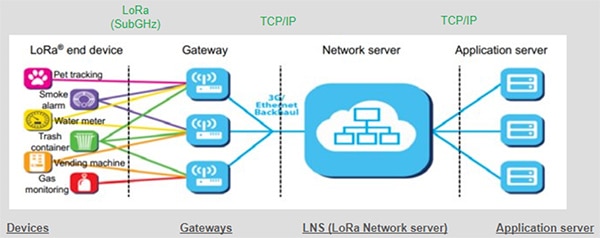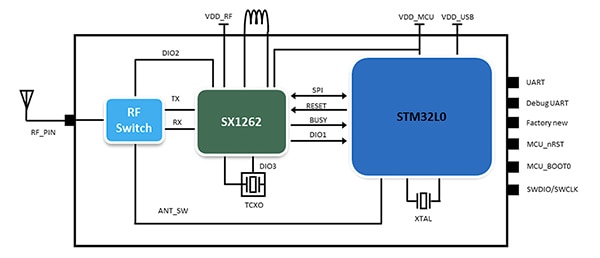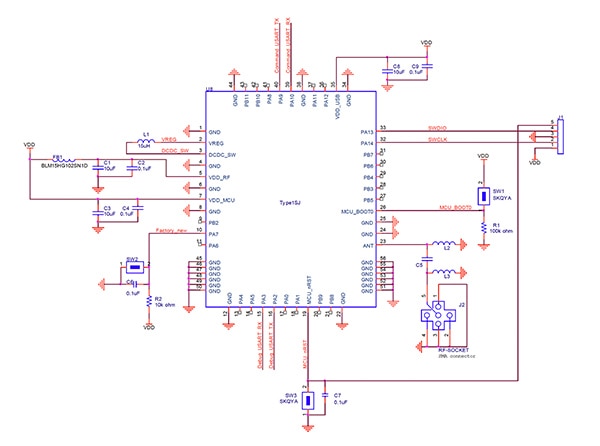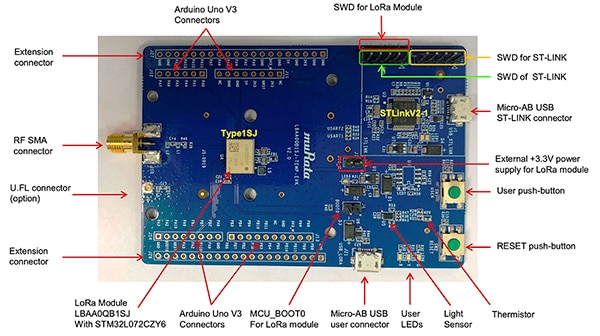Speed Development of Long-Range Connectivity with a Certified LoRaWAN Module
Contributed By DigiKey's North American Editors
2023-08-24
In many high-volume, sensor-based applications for agriculture, asset tracking, utilities, and the Internet of Things (IoT), developers need to provide secure connectivity across extended operating ranges. Designed to support very large networks of such devices, the long-range, wide-area network (LoRaWAN) protocol can provide an effective solution, but it requires suitable familiarity and expertise to implement an optimized communications subsystem quickly.
This article briefly describes LoRaWAN and its capabilities. It then introduces a LoRaWAN-certified module from Murata Electronics that offers developers a drop-in solution for achieving extremely long-range connectivity through low-power, wide-area networks (LPWANs). To accelerate prototyping, its development board and software support are also introduced.
What is LoRaWAN?
Among available wireless connectivity options, LoRaWAN has emerged as an effective solution for server-based applications that connect with low-power end devices that are located well beyond the range of familiar wireless options such as Wi-Fi or Bluetooth. In a LoRaWAN network, application servers communicate through conventional Transmission Control Protocol/Internet Protocol (TCP/IP) networks with LoRaWAN gateways (Figure 1).
 Figure 1: In a typical LoRaWAN network application, servers connect to gateways which in turn use the long-range, low-power capabilities of LoRa technology to connect end devices that could be located many kilometers away. (Image source: Murata Electronics)
Figure 1: In a typical LoRaWAN network application, servers connect to gateways which in turn use the long-range, low-power capabilities of LoRa technology to connect end devices that could be located many kilometers away. (Image source: Murata Electronics)
LoRaWAN gateways, in turn, communicate with end devices using LoRa sub-gigahertz radio frequency (RF) technology operating in the unlicensed industrial, scientific, and medical (ISM) frequency bands. Intended for relatively low bitrate applications, LoRa technology offers a maximum bitrate of about 10 kilobits per second (Kbits/s), but it has unique advantages for long-range applications.
Based on spread spectrum technology, LoRa RF lets developers trade bitrate for range, easily achieving reliable two-way communications at distances of over 15 kilometers (km) in rural areas or over 5 km in indoor locations in dense urban areas.
The LoRaWAN protocol protects communications traffic thanks to LoRaWAN’s security model. LoRaWAN uses a pair of security keys: one to ensure authenticity and integrity at the packet level and another to provide end-to-end security of messages between end devices and application servers.
The LoRaWAN protocol offers further advantages for balancing the power consumption of end devices with the communications needs of the application. A LoRaWAN network allows devices to operate in one of three classes: Class A, Class B, or Class C. A device in any class can transmit messages as needed, but its class determines when it can receive messages.
Class A devices are the most energy efficient, designed for event-driven operation, such as when a sensor detects a change in its environment. Class A devices can remain sleeping between events, waking after sensor data acquisition only long enough to transmit data, and then subsequently open downlink receive windows at specified delays (RX1 and RX2) following the uplink transmission (Figure 2).
 Figure 2: The most energy-efficient of LoRaWAN classes, Class A operation, allows devices to sleep as long as possible, becoming active only to transmit (uplink) data to gateways and subsequently open a first receive window (RX1) and a second receive window (RX2) after the uplink completes. (Image source: Murata Electronics)
Figure 2: The most energy-efficient of LoRaWAN classes, Class A operation, allows devices to sleep as long as possible, becoming active only to transmit (uplink) data to gateways and subsequently open a first receive window (RX1) and a second receive window (RX2) after the uplink completes. (Image source: Murata Electronics)
Class B devices support periodic operation on a schedule required by the application. For Class B devices, the LoRaWAN protocol allows devices to open a downlink receive window on a specified schedule, using a gateway-transmitted beacon to synchronize the end device with the network (Figure 3).
 Figure 3: LoRaWAN Class B devices enable synchronized downlinks using a beacon transmitted by the connected gateway to maintain timing. (Image source: Murata Electronics)
Figure 3: LoRaWAN Class B devices enable synchronized downlinks using a beacon transmitted by the connected gateway to maintain timing. (Image source: Murata Electronics)
Class C devices are designed for applications that require end devices to listen continuously for downlink messages. Because Class C devices are required to remain active, they are typically line powered rather than battery powered, as with Class A and even Class B devices (Figure 4).
 Figure 4: Typically powered by a constant power source, LoRaWAN Class C devices always remain active, constantly listening for downlink messages when not transmitting uplink messages. (Image source: Murata Electronics)
Figure 4: Typically powered by a constant power source, LoRaWAN Class C devices always remain active, constantly listening for downlink messages when not transmitting uplink messages. (Image source: Murata Electronics)
Although seemingly straightforward in concept, LoRaWAN network implementation requires significant knowledge and experience to find the right balance between the detailed operating parameters of the LoRaWAN protocol and its underlying LoRa technology.
Certified LoRaWAN module offers a drop-in solution
Murata Electronics’ LBAA0QB1SJ-296 module and associated firmware offer a drop-in solution to accelerate LoRaWAN network connectivity, providing a complete LoRaWAN-certified solution for end devices. The module integrates Semtech’s SX1262 LoRa transceiver, STMicroelectronics’ STM32L072 microcontroller with 192 kilobytes (Kbyte) of flash memory, an RF switch, and a temperature-compensated crystal oscillator (TCXO). It comes in a shielded resin-molded package measuring only 10.0 x 8.0 x 1.6 millimeters (mm) (Figure 5).
 Figure 5: Providing a complete LoRaWAN connectivity solution, Murata Electronics’ LBAA0QB1SJ-296 module integrates a Semtech SX1262 LoRa transceiver and an STMicroelectronics STM32L072 microcontroller running a preloaded LoRaWAN stack. (Image source: Murata Electronics)
Figure 5: Providing a complete LoRaWAN connectivity solution, Murata Electronics’ LBAA0QB1SJ-296 module integrates a Semtech SX1262 LoRa transceiver and an STMicroelectronics STM32L072 microcontroller running a preloaded LoRaWAN stack. (Image source: Murata Electronics)
Operating from a single 3.3 volt supply, the module consumes only 15.5 milliamperes (mA) with a 125 kilohertz (kHz) bandwidth while offering a receiver sensitivity of -135.5 decibels referenced to 1 milliwatt (mW) (dBm) at a packet error rate of 1% at the same bandwidth and maximum spreading factor. The spreading factor is defined as the number of chirps per bit in LoRa’s chirp spread spectrum technology implementation. For transmission, the module offers up to +21.5 dBm transmit power while consuming 118 mA at maximum transmit power.
The LBAA0QB1SJ-296 module supports LoRaWAN Class A, B, or C, offering several low-power operating modes that allow developers to balance performance and power consumption. For battery-powered end devices (typically operating in Class A or Class B), the module can operate in an ultra-low-power mode that consumes only about 1.3 microamperes (µA) with real-time clock operation, enabling operation for years.
Rapid development of LoRaWAN-connected devices
Using the LBAA0QB1SJ-296 module to add LoRaWAN connectivity to an end-device system is relatively straightforward. On the hardware side, the module connects to an end-device host processor through the module’s universal asynchronous receiver/transmitter (UART) interface. Besides the UART interface for host communications, the module requires only an external antenna and a few additional components to provide a complete LoRaWAN hardware subsystem (Figure 6).
 Figure 6: Using the Murata Electronics LBAA0QB1SJ-296 module, developers need only a few additional components to add certified LoRaWAN connectivity to their end-device designs. (Image source: Murata Electronics)
Figure 6: Using the Murata Electronics LBAA0QB1SJ-296 module, developers need only a few additional components to add certified LoRaWAN connectivity to their end-device designs. (Image source: Murata Electronics)
On the software side, the LBAA0QB1SJ-296 module comes preconfigured with a complete stack for LoRaWAN operation in the 915 megahertz (MHz) ISM band. In operation, the end-device host processor manages and monitors module operation using an AT command set.
Although the module’s hardware interface and preloaded firmware help speed custom development, Murata’s LBAA0QB1SJ-TEMP-EVK evaluation board lets developers get started immediately with rapid prototyping and accelerated development of production designs (Figure 7).
 Figure 7: Designed to speed evaluation and rapid prototyping of LoRaWAN connectivity, Murata’s LBAA0QB1SJ-TEMP-EVK evaluation board combines an LBAA0QB1SJ-296 module with peripherals and connectors. (Image source: Murata Electronics)
Figure 7: Designed to speed evaluation and rapid prototyping of LoRaWAN connectivity, Murata’s LBAA0QB1SJ-TEMP-EVK evaluation board combines an LBAA0QB1SJ-296 module with peripherals and connectors. (Image source: Murata Electronics)
The evaluation board supports the onboard LBAA0QB1SJ-296 module with several user interface devices, including light-emitting diodes (LEDs), a thermistor, and pushbuttons. Developers can further extend board functionality by adding needed peripherals using the board’s Arduino Uno V3 connectors.
To begin evaluating LoRaWAN for their application, developers only need to attach a suitable 915 MHz RF subminiature version A (SMA) antenna, supply power from an external source, and connect the board through its USB connector to a host development system.
After the board comes up, developers can test module operation using a terminal emulation program or a graphical user interface (GUI) test tool available to registered board users. For extended debugging, the board provides a serial wire debug (SWD) and USB connector for connecting an STMicroelectronics ST-LINK debugger/programmer.
For end-to-end application evaluation and software debugging, developers can simply add a readily available LoRaWAN gateway to complete the communications link between the evaluation board and application servers.
Conclusion
The LoRaWAN protocol and underlying LoRa technology provide an effective solution for connecting end devices across extended distances without compromising limited power budgets. Designed to speed the deployment of low-power, wide-area networks, Murata Electronics’ LBAA0QB1SJ-296 module provides a LoRaWAN-certified drop-in solution. Using Murata Electronics’ LBAA0QB1SJ-296-based LBAA0QB1SJ-TEMP-EVK evaluation board, developers can rapidly prototype and evaluate their LoRaWAN network applications.

Disclaimer: The opinions, beliefs, and viewpoints expressed by the various authors and/or forum participants on this website do not necessarily reflect the opinions, beliefs, and viewpoints of DigiKey or official policies of DigiKey.










